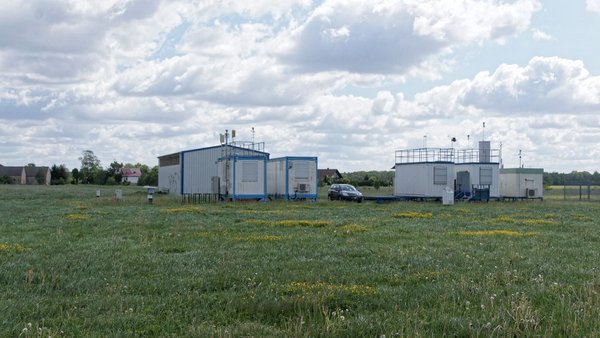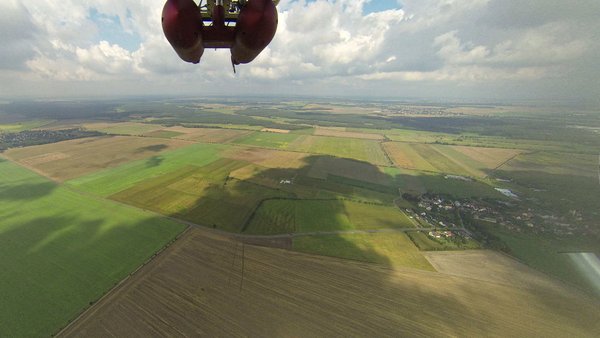Eastern air has become cleaner
Leipzig,
28.04.2025
Long-term study from Saxony shows decreasing air pollution
Leipzig. Air pollution with particulate matter smaller than 1 micrometer has fallen by an average of 5 per cent annually in rural Saxony. However, the decreases were particularly marked in air masses coming from Eastern Europe: PM1 concentrations fell by as much as 28 per cent per year. The organic content of the particles, on the other hand, decreased significantly less at only 2 per cent per year: while organic particles from the combustion of mineral oil and coal remained roughly constant, the proportion from biomass combustion increased slightly by half a per cent per year, which indicates an increased use of wood for heating and/or more forest fires. This is the conclusion reached by researchers from the Leibniz Institute for Tropospheric Research (TROPOS), the University of Modena, and MeteoSwiss after analyzing a ten-year series of measurements taken at the TROPOS rural background station Melpitz near Leipzig. The data from the years 2012 to 2022 enables a much more detailed chemical analysis than before, thanks to online measurement methods. The results show how important long-term measurements are for analysing air pollution control measures, the researchers write in the scientific journal Atmospheric Environment.
Aerosol particles affect climate and health. According to estimates by the European Environment Agency (EEA), around 293,000 people in Europe died in 2021 due to air pollution. Although air quality has been monitored for many years, there is still a lack of knowledge about how the sources of particulate matter change over the years and how this affects the chemical composition of particulate matter in Central Europe. The development of online approaches based on aerosol mass spectrometers like the Aerosol Chemical Speciation Monitor (ACSM) used in this study not only provides high time resolution results on the aerosol chemical composition but also provides a unique opportunity to access the identification of organic aerosol sources. Compared to standard 24h daily filter measurements, such an approach makes the assignment of wind directions much clearer, as these are rarely constant over 24 hours. In Germany, only two of these ACSM devices have been continuously used for several years: one at the DWD Hohenpeißenberg observatory in Bavaria and one at the TROPOS research station Melpitz in Saxony. The present measurements made at Melpitz are part of the ACTRIS EU research network as well as the EMEP European air monitoring network. The station is located in the lowlands of Saxony and is representative of large parts of rural eastern Germany, and is located on the border between the Atlantic and continental climate, which makes it particularly interesting for large-scale analyses in Europe.
In 2008, the EU Air Quality Directive set an annual average limit value of 40 micrograms per cubic meter for the particulate matter fraction PM10 to protect human health. From 2030, however, the EU limit value for PM10 is to be lowered to 20 micrograms per cubic meter, and the annual limit value for PM2.5 is to be reduced by more than half, from 25 to 10 micrograms per cubic meter. The World Health Organisation (WHO) even recommends only half of this, i.e., 5 micrograms per cubic meter. There are currently no limit values for small particulate matter, such as the PM1 measured here. However, scientists consider them to be an important indicator of the negative effects on human health because these small fine dust fractions, in contrast to coarse dust, penetrate deep into the lungs and can then trigger inflammatory reactions in the body via the bloodstream.
From 2012 to 2022, the particulate mass concentration of PM1 (i.e., particles having a diameter smaller than 1 micrometer) in Melpitz averaged just under 10 micrograms per cubic meter with some important year-to-year seasonal change ranging from 5.6 µg m-3 in fall 2019 to almost 16 µg m-3 in winter 2016-2017. Organic components accounted for almost half the particle concentration, followed by nitrate, sulphate, ammonium, and equivalent black carbon (eBC). The decrease in the total mass concentration of organic components in Melpitz by just under 5 per cent per year is primarily due to the reduction of nitrate and eBC (around 1 per cent per year each). "These decreases illustrate the positive impact of clean air measures in Europe, particularly those targeting transport-related emissions such as NOx and eBC. Eastern European air masses consistently had higher pollution levels than Western European ones, but this difference decreased over time, indicating potential improvements in air quality in the East," explains Samira Atabakhsh from TROPOS.
Source identification on the organic aerosol fraction provides a good indication of trends for fossil fuels and biomass from wood combustion and forest fires. From the five identified sources, three were associated with anthropogenic sources like mineral oil combustion (e.g., car exhaust and house heating named HOA for Hydrocarbon-like organic aerosol), biomass burning (e.g., wood combustion, named BBOA), and coal combustion (named CCOA), while the remaining two were not specifically linked to aged anthropogenic or biogenic sources (LO-OOA and MO-OOA). The five groups (HOA, BBOA, CCOA, LO-OOA, and MO-OOA) contributed on average 7, 10, 12, 31, and 40 per cent of the organic aerosol, respectively:
Hydrocarbon-like OA (HOA) is a clear indicator of mineral oil combustion in car engines and heating systems. These HOA concentrations remained stable overall, indicating constant local emissions, but a slight decrease was observed for easterly winds (0.25 percent per year).
Biomass-burning OA (BBOA) and coal-combustion OA (CCOA) showed higher concentrations in eastern air masses, emphasizing the influence of emissions via long-distance transport. BBOA contributions increased slightly in winter (0.32 per cent over the decade), indicating increased biomass combustion for heating purposes in private households. Surprisingly, CCOA showed an increasing trend in westerly winds (0.27 per cent per year), possibly due to higher coal use in Western European power plants.
Further investigations are necessary here to investigate how the trend will continue to change in the coming years but also compare the results at different places. Such a comparison will soon be possible by taking advantage of the different European observatories equipped with appropriate instruments within the EU research infrastructure ACTRIS. It will then be possible in the future to track the changes in European air much better and identify the causes more easily.
"Our long-term measurements in a background site clearly illustrate that European and national air quality policies and energy not only affect the urban air quality, but also affect rural and background environment via long-range transport processes," emphasizes Dr Laurent Poulain from TROPOS. "The results show how important it is to investigate changes in the mass concentration and distribution of the sources and chemical species that contribute to the overall particulate matter mass concentration." Such an approach is important not only for tracking the distribution of sources or chemical species in the particles but also for predicting changes in the physical properties of the aerosol, such as hygroscopicity, light absorption, or scattering. The inclusion of such trends in prediction models could improve the understanding of long-term changes in the properties of aerosol particles and ultimately contribute to improvements in climate modelling.
Tilo Arnhold
Publication:
Atabakhsh, Samira & Poulain, Laurent & Bigi, Alessandro & Collaud Coen, Martine & Pöhlker, Mira & Herrmann, Hartmut. (2025). Trends of PM1 aerosol chemical composition, carbonaceous aerosol, and source over the last 10 years at Melpitz (Germany). Atmospheric Environment. 346. 121075. 10.1016/j.atmosenv.2025.121075. < 1 April 2025>
https://doi.org/10.1016/j.atmosenv.2025.121075
The research was funded by the European Science Foundation (European Cooperation in Science and Technology (grant no. CA16109)) and the European Union (ACTRIS (262254), ACTRIS-2 (654109) & H2020 Research Infrastructures (grant no. RI-URBANS (101036245)).
Contacts for the media:
Samira Atabakhsh/ Dr Laurent Poulain
Research Associate, Atmospheric Chemistry Department (ACD), Leibniz Institute for Tropospheric Research (TROPOS), Leipzig
Phone +49-341-2717- 7073, -7316
https://www.tropos.de/en/institute/about-us/employees/samira-atabaksh
https://www.tropos.de/en/research/atmospheric-aerosols/long-term-trends-and-process-analysis/long-term-studies-of-regional-importance-and-air-quality/regional-research-station-melpitz/overview
and
Prof Dr Hartmut Herrmann
Head, Atmospheric Chemistry Department (ACD), Leibniz Institute for Tropospheric Research (TROPOS), Leipzig
Phone +49-341-2717-7024
https://www.tropos.de/institut/ueber-uns/mitarbeitende/hartmut-herrmann
or
Tilo Arnhold, TROPOS Public Relations
Phone +49 341 2717-7189
http://www.tropos.de/aktuelles/pressemitteilungen/
Further information and links:
TROPOS Melpitz research station https://www.tropos.de/en/research/atmospheric-aerosols/long-term-trends-and-process-analysis/long-term-studies-of-regional-importance-and-air-quality/regional-research-station-melpitz/overview
Characterisation of chemical aerosol properties https://www.tropos.de/forschung/atmosphaerische-aerosole/langzeit-prozess-und-trendanalysen/langzeitstudien-regionaler-bedeutung-und-luftqualitaet/regionale-forschungsstation-melpitz/charakterisierung-chemischer-aerosoleigenschaften
Aerosol mass spectrometer (ACSM) https://www.dwd.de/DE/forschung/atmosphaerenbeob/zusammensetzung_atmosphaere/aerosol/inh_nav/acsm_node.html
Wood-fired heating systems pollute the air in mountain regions more than previously assumed (TROPOS press release, 26/07/2022) https://www.tropos.de/aktuelles/pressemitteilungen/details/holzheizungen-verschmutzen-die-luft-in-gebirgsregionen-staerker-als-bisher-angenommen
Soot from heating systems and traffic is not just a local problem. Study from Thuringia shows: 50 per cent of harmful soot comes from local sources and 50 per cent from long-distance transport (TROPOS press release, 10.06.2021) https://www.tropos.de/aktuelles/pressemitteilungen/details/russ-aus-heizungen-und-verkehr-ist-nicht-nur-ein-lokales-problem
TROPOS research for clean air https://www.tropos.de/entdecken/forschung-fuer-saubere-luft
ACTRIS Observational Platforms https://www.actris.eu/facilities/national-facilities/observational-platforms
The Leibniz Institute for Tropospheric Research (TROPOS) is a member of the Leibniz Association, which unites 96 independent research institutions. Their focus ranges from the natural, engineering and environmental sciences to economics, spatial and social sciences and the humanities. Leibniz Institutes are dedicated to socially, economically and ecologically relevant issues.
They conduct knowledge- and application-oriented research, including in the overarching Leibniz Research Alliances, are or maintain scientific infrastructures and offer research-based services. The Leibniz Association focuses on knowledge transfer, especially with the Leibniz Research Museums. It advises and informs politics, science, business and the public.
Leibniz institutions maintain close cooperation with universities - including in the form of the Leibniz ScienceCampi, with industry and other partners in Germany and abroad. They are subject to a transparent and independent review process. Due to their national importance, the federal and state governments jointly fund the institutes of the Leibniz Association. The Leibniz Institutes employ around 21,300 people, including 12,200 scientists.
The financial volume amounts to 2.2 billion euros. They are financed jointly by the federal and state governments. The basic funding of the Leibniz Institute for Tropospheric Research (TROPOS) is provided by the Federal Ministry of Education and Research (BMBF) and the Saxon State Ministry of Science and the Arts (SMWK). The institute is co-financed from tax revenue on the basis of the budget approved by the Saxon State Parliament.
http://www.leibniz-gemeinschaft.de
https://www.bmbf.de/
https://www.smwk.sachsen.de/







